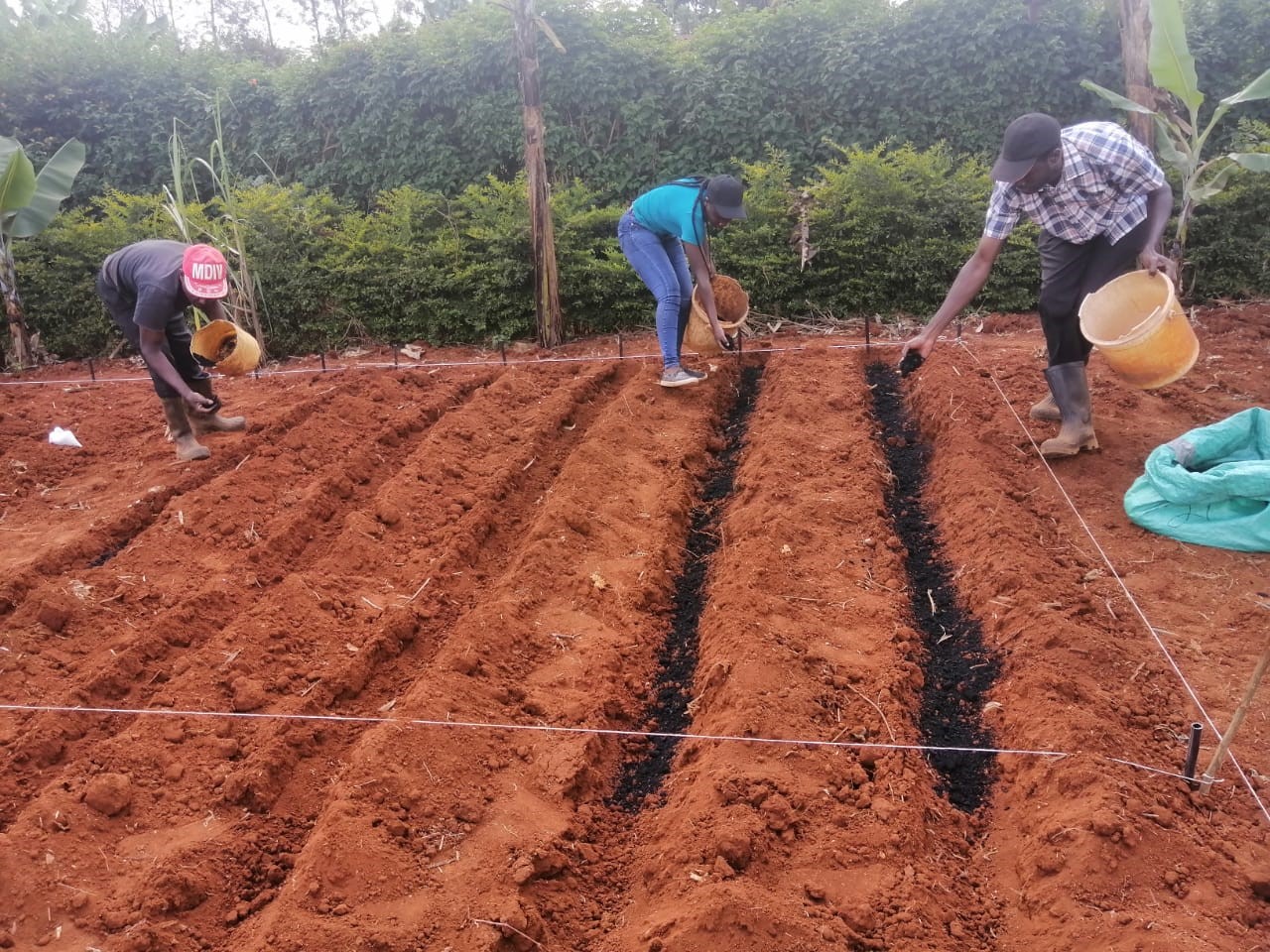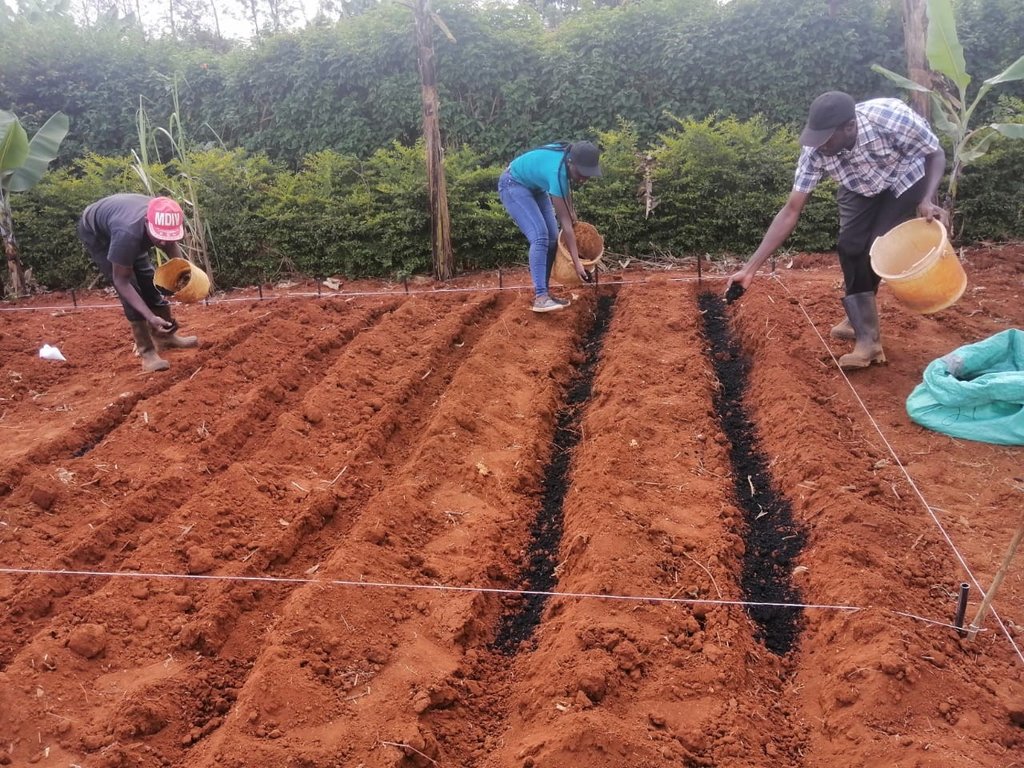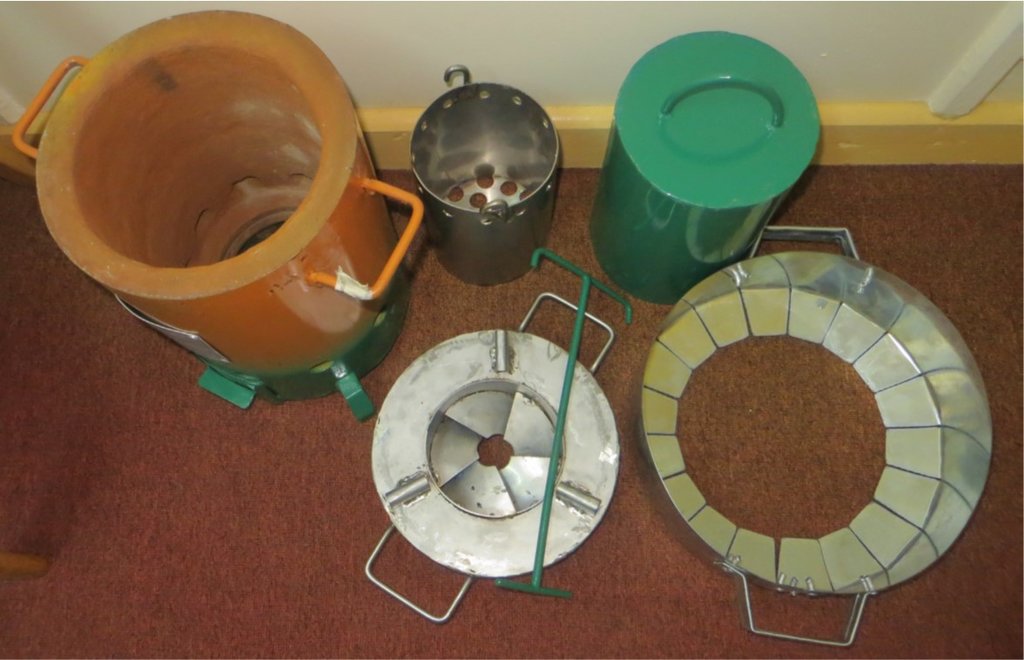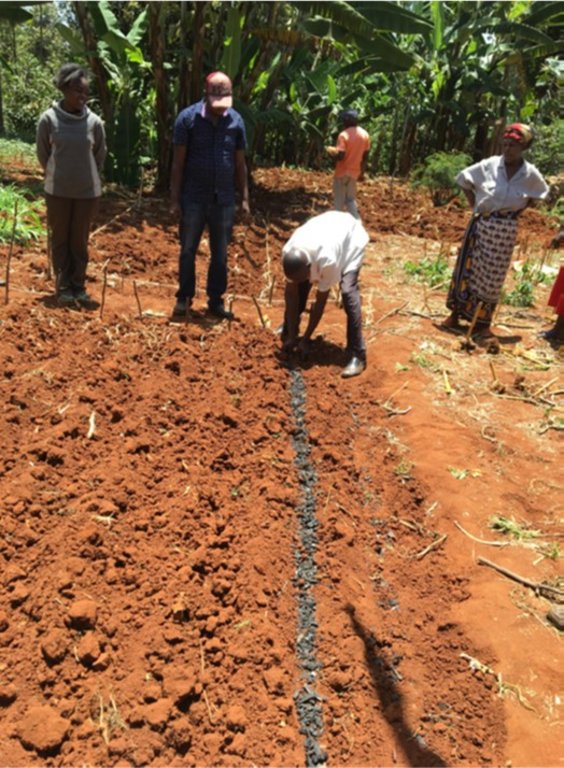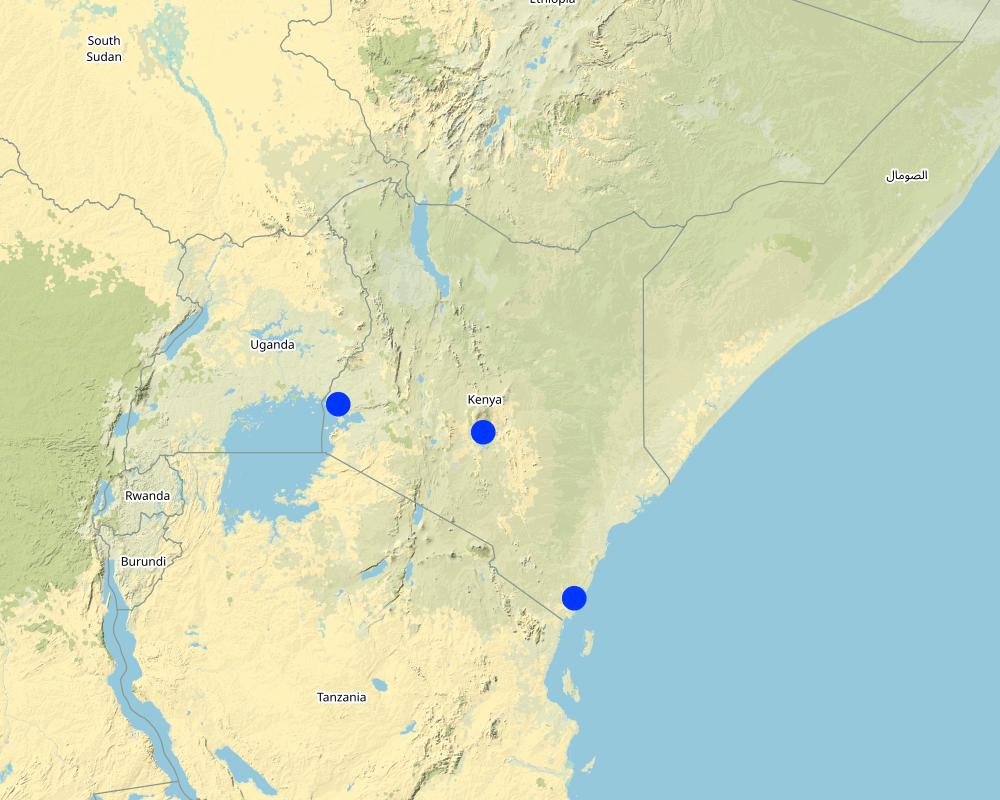Biochar application by smallholder farmers [Кения]
- Создание:
- Обновить:
- Составитель: Niels Thevs
- Редактор: Dries Roobroeck
- Рецензенты: William Critchley, Rima Mekdaschi Studer
technologies_6349 - Кения
Просмотреть разделы
Развернуть все Свернуть все1. Общая информация
1.2 Контактные данные специалистов и организаций, участвующих в описании и оценке Технологии
co-compiler:
co-compiler:
Roebroock Dries
IITA
Кения
Название организации (-ий), содействовавших документированию/оценке Технологии (если применимо)
Deutsche Gesellschaft für Internationale Zusammenarbeit (GIZ) GmbH (GIZ) - Германия1.3 Условия, регламентирующие использование данных, собранных ВОКАТ
Составитель и ответственный(-ые) специалист(-ы) согласны с условиями, регламентирующими использование собранных ВОКАТ данных:
Да
1.4 Декларация по устойчивости описываемой Технологии
Вызывает ли описанная здесь Технология проблемы деградации земель настолько, что ее нельзя назвать природосберегающей?
Нет
2. Описание Технологии УЗП
2.1 Краткое описание Технологии
Определение Технологии:
Application of biochar to soils in the tropics / sub-tropics improves their ability to store and supply nutrients and water for crop growth, thereby enhancing yields and food security. At the same time, biochar holds carbon in soils for extended time periods, which makes it an agricultural practice that contributes to climate change mitigation.
2.2 Подробное описание Технологии
Описание:
Biochar is carbonised organic material that is produced through pyrolysis, that is thermal conversion under low or no oxygen. The biochar is used as an amendment to farmland for ameliorating soil properties. Owing to the great number of micropores and charges on biochar, its application to soil boosts water and nutrient storage, and their delivery to crops. Biochar also helps neutralise acidity in soils, replacing the need for lime. All these positive effects make it ideally suited for acid, nutrient-poor soils in tropical/ sub-tropical regions. Even at low rates of 1 or 2 tonnes per hectare, biochar significantly increases crop production. Biochar hardly decomposes in soils, causing positive effects to last for several years without repeat application. This also provides very stable carbon storage on farms which helps mitigate climate change. Its stability also allows farmers to gradually add biochar to the entire farm, thereby increasing their food self-sufficiency and incomes.
Biochar itself is not a fertilizer, but a soil rejuvenating agent. Therefore, farmers must apply essential nutrients through synthetic or organic inputs to reap the full yield potential and maintain soil fertility. Yet, when biochar is combined with fertilizers, about 40% - 70% nitrogen and phosphorus can be saved over multiple seasons while maintaining the same productivity. Biochar is a promising solution to address low response of crops to fertilizer addition in tropical soils and to alleviate the impact of input price hikes and supply disruptions.
In the study presented here, farmers produced biochar as a residue from small gasifier stoves during daily cooking. These systems are highly energy efficient and reduce the consumption of firewood while improving indoor air quality, which, alongside crop yield gains from biochar, is perceived positively by farmers. The specific design of gasifier stoves requires them to be well-packed with appropriately sized tree prunings or maize stems. For larger meals it requires a refill, which users find less convenient than their traditional open combustion fires. Life-cycle assessment shows that households significantly reduce greenhouse gas emissions with the gasifier stoves when biochar is applied to the farm. For the field trials with maize and kale in this study, farmers applied their usual rates of inorganic fertilizers, animal manure, or a combination of both. Results from this multi-locational participatory assessment showed that maize grain yield increased by 0.2 - 0.7 tonnes per hectare for every tonne of home-made biochar that was added to the field.
One household can produce 300 kg biochar per year by cooking on the gasifier stove. With this amount a biochar dosage of 1.5 t/ha can be realized on an area of 0.2 ha per year. If biochar is not spread evenly, but along seed rows, its effective dosage can be increased. As the gasifier stove can be operated for 2-3 years, it is assumed that the costs of 50 USD, which are needed to purchase one gasifier, are good to equip 1 ha of land with an amount of biochar that results in increased crop yields.
2.3 Фотографии, иллюстрирующие Технологию
Комментарии к фотографиям:
Both photographs were taken from the publication: Njenga M, Sundberg C, Gitau JK, Mahmoud Y, Röing de Nowina K, Mendum R and Karltun E 2020. Biochar stoves for socio-ecological resilience: Lessons from small-scale farms in rural Kenya. Policy Brief No 51. Nairobi, Kenya. World Agroforestry (ICRAF)
2.5 Страна/ регион/ места, где применяется Технология, информация о которых собрана в данной Анкете
Страна:
Кения
Административная единица (Район/Область):
Embu County, Kwale County, Siaya County
Охарактеризуйте пространственное распространение Технологии :
- примененяется точечно/ на небольших участках
Технология применяется на ООПТ?
Нет
Map
×2.6 Сколько лет применяется данная Технология
Год начала реализации:
2016
2.7 Внедрение Технологии
Укажите, как именно Технология УЗП была внедрена:
- в качестве научного/ полевого эксперимента
Пояснения (тип проекта и т.д.):
IITA (International Institute of Tropical Agriculture) started a long-term field trial in 2006, in which crop and soil properties were monitored following one initial biochar application of 100 t/ha. ICRAF investigated the charcoal value chain in Kenya and, among others, promoted cooking stoves which were more efficient than the traditionally used open fires. Those stoves run on pyrolysis, which provides heat for cooking and charcoal as a residual. That charcoal can be used for cooking so that the initial biomass is used more efficiently as an energy source. Or, alternatively, the residual charcoal is used as biochar to improve the farmers' soils.
This combination of cooking and biochar production and application to soils began in 2016 as participatory research.
3. Классификация Технологии УЗП
3.1 Основные цели и задачи реализации Технологии
- повышение производства
- адаптация к изменению климата / экстремальным погодным явлениям и их последствиям
- смягчение последствий изменения климата
- создание благоприятных экономических условий
- создание благоприятных социальных условий
3.2 Текущий(-ие) тип(-ы) землепользования на территории, где применяется Технология
Комбинированное землепользование в пределах одной и той же земельной единицы:
Нет

Пахотные угодья и плантации
- Однолетние культуры
Ежегодный урожай - Уточните культуры:
- зерновые культуры - кукуруза
- овощи - листовые овощи (салаты, капуста, шпинат, другие)
Число урожаев за год:
- 2
Поясните:
2 seasons in Embu and Siaya, 1 season in Kwale
Применяются ли посевы в междурядьях?
Да
Если да, укажите, какие посевы применяются:
Part of the households intercrop maize with beans.
Применяется ли севооборот?
Нет
3.3 Изменилось ли использование земель в связи с внедрением Технологии?
Изменилось ли использование земель в связи с внедрением Технологии?
- Нет (см. пункт 3.4)

Пахотные угодья и плантации
- Однолетние культуры
Ежегодный урожай - Уточните культуры:
- зерновые культуры - кукуруза
Применяются ли посевы в междурядьях?
Да
Если да, укажите, какие посевы применяются:
maize and beans
Применяется ли севооборот?
Нет
3.4 Водоснабжение
Обеспеченность водой участков, где реализуется Технология :
- богарные земли
3.5 Категория УЗП, к которой относится Технология
- Комплексное управление почвенным плодородием
3.6 Мероприятия УЗП, выполняемые в рамках Технологии

Агрономические мероприятия
- A2: Органическое вещество/ почвенное плодородие
3.7 Основные проблемы деградации земель, на решение которых направлена Технология

ухудшение химических свойств почв
- Хп: Снижение плодородия и уменьшение содержания органического вещества (вызванное не эрозией, а другими причинами)
- Хк: подкисление

ухудшение физических свойств почв
- Фу: уплотнение
- Фп: запечатывание почв
Пояснения:
Biochar increases the cation exchange capacity of soils and enhances the plant availability of phosphorus so that it contributes to soil fertility. Biochar increases the soil pH so that it treats acidification of soils. In the field of soil physical properties, biochar decreases the bulk density of soils and adds pore space to soils so that the infiltration into the soil and the usable field capacity of soils are increased. In this specific case, soil sealing and compaction do not play a role, but biochar can address those soil degradation issues.
3.8 Предотвращение и снижение деградации земель, или восстановление нарушенных земель
Укажите цель Технологии по отношению к деградации земель :
- снижение деградации земель
- восстановление/ реабилитация нарушенных земель
4. Технические характеристики, мероприятия по практической реализации, вложения и стоимость
4.2 Общая информация по необходимым вложениям и стоимости
Уточните, как рассчитывались затраты и вложения:
- на технологическую единицу
Укажите единицу:
one gasifier cooking stove and the resulting amount of biochar
Укажите денежные единицы, использованные для подсчета затрат:
- Доллары США
4.3 Мероприятия, необходимые для начала реализации
| Деятельность | Время (сессия) | |
|---|---|---|
| 1. | Biochar production | Year-round while using the gasifier cooking stove. |
| 2. | Mixing biochar into the soil | During the normal time of field preparation for and planting of the next crop |
| 3. | Proceed with normal cropping activities |
Пояснения:
This SLM technique adds biochar to the ongoing cropping activities. So, the choice of crops, soil preparation, planting, inputs, and harvest do not change after biochar application. The biochar is sourced from so-called gasifier cooking stoves, which are stoves that perform through pyrolysis. The excess energy of that pyrolysis is used for cooking, while the residual char is applied as biochar to the farmers' field. Char (biochar) is produced during every cooking activity, collected, and finally applied. Most household in the project regions use open three-stone fires for cooking followed by charcoal. Adoption of the gasifier stoves is a shift away from the open fires and charcoal.
4.4 Вложения и затраты, необходимые для начала реализации
| Опишите затраты | Единица | Количество | Затраты на единицу | Общая стоимость на единицу | % затрат, оплаченных землепользователями | |
|---|---|---|---|---|---|---|
| Оплата труда | gasifier cooking stove | 1,0 | 50,0 | 50,0 | ||
| Общая стоимость запуска Технологии | 50,0 | |||||
| Общие затраты на создание Технологии в долларах США | 50,0 | |||||
Пояснения:
As costs we only listed the 50 USD per gasifier cooking stove. As the other farm operations do not change, no further costs for plant materials or fertilizers or other were listed, because those inputs do not change solely due to the use of biochar from the gasifier stoves.
One household can produce 300 kg biochar per year by cooking on the gasifier stove. With this amount a biochar dosage of 1.5 t/ha can be realized on an area of 0.2 ha per year. If biochar is not spread evenly, but along seed rows, its effective dosage can be increased. As the gasifier stove can be operated for 2-3 years, it is assumed that the costs of 50 USD are good to equip 1 ha of land with an amount of biochar that results in increased crop yields.
4.5 Поддержание/ текущее обслуживание
| Деятельность | Сроки/ повторяемость проведения | |
|---|---|---|
| 1. | Replace the gasifier cooking stove | every three years |
Пояснения:
Once biochar has been applied into a given soil, it sits there in the soil and does not require further maintenance. The farming activities and their associated labor remain unchanged compared to the the time before biochar application.
4.6 Стоимость поддержания/ текущего обслуживания ( в год)
| Опишите затраты | Единица | Количество | Затраты на единицу | Общая стоимость на единицу | % затрат, оплаченных землепользователями | |
|---|---|---|---|---|---|---|
| Оборудование | gasifier cooking stove | 1 | 0,33 | 50,0 | 16,5 | 100,0 |
| Общая стоимость поддержания Технологии | 16,5 | |||||
| Общие затраты на поддержание Технологии в долларах США | 16,5 | |||||
Пояснения:
The depreciation of the gasifier cooking stove and the need to replace it every three years is included here unde rrecurrent costs.
4.7 Наиболее значимые факторы, влияющие на стоимость затрат
Опишите наиболее значимые факторы, влияющие на стоимость затрат:
Purchase price of the gasifier stove. Opportunity cost for collection and pre-processing of tree prunings and crop residues for the stove.
5. Природные и социально-экономические условия
5.1 Климат
Среднегодовое количество осадков
- < 250 мм
- 251-500 мм
- 501-750 мм
- 751-1000 мм
- 1001-1500 мм
- 1501-2000 мм
- 2001-3000 мм
- 3001-4000 мм
- > 4000 мм
Пояснения/ комментарии по осадкам:
Embu: 1200 mm, Siaya: 1350 mm, Kwale 1050 mm
Агроклиматическая зона
- Умеренно-влажная
5.2 Рельеф
Склоны (преобладающие):
- пологие (0-2%)
- покатые (3-5%)
- покато-крутые (6-10%)
- крутые (11-15%)
- очень крутые (16-30%)
- чрезвычайно крутые (31-60%)
- обрывистые (>60%)
Формы рельефа:
- плато/ равнины
- гребни хребтов/холмов
- склоны гор
- склоны холмов
- подножья
- днища долин
Зона высотной поясности:
- 0-100 м над уровнем моря
- 101-500 м н.у.м.
- 501-1000 м н.у.м.
- 1001-1500 м н.у.м.
- 1501-2000 м н.у.м.
- 2001-2500 м н.у.м.
- 2501-3000 м н.у.м.
- 3001-4000 м н.у.м.
- > 4 тыс. м н.у.м.
Укажите, приурочено ли применение Технологии к специфическим условиям:
- не имеет значения
Комментарии и дополнительные сведения по условиям рельефа/ топографии :
Kwale: 328 m a.s.l.
Embu: 1350 m a.s.l.
5.3 Почвы
Средняя мощность почв:
- поверхностные (0-20 см)
- неглубокие (21-50 см)
- умеренно глубокие (51-80 см)
- глубокие (81-120 см)
- очень глубокие (> 120 см)
Гранулометрический состав (верхнего горизонта):
- средние фракции (суглинистый, супесчаный)
Гранулометрический состав (на глубине более 20 см):
- средние фракции (суглинистый, супесчаный)
Содержание органического вещества в верхнем горизонте:
- среднее (1-3%)
Если возможно, приложите полное описание почв или укажите доступную информацию, например тип почв, рH/ кислотность почв, ёмкость катионного обмена, содержание азота, содержание солей и т.д.
The following information are available for two field plots out of the three counties:
Embu County: pH(H2O) - 5.01, SOC - 2.01%, sand - 21%, clay - 43.5%
Siaya County: pH(H2O) - 5.25, SOC - 1.56%, sand - 22.4%, clay - 60.1%
5.4 Доступность и качество воды
Доступность поверхностных вод:
хорошая
Качество воды (без обработки):
питьевая вода плохого качества (необходима обработка)
5.6 Характеристика землепользователей, применяющих Технологию
Осёдлый или кочевой:
- Осёдлый
Рыночная ориентация производства:
- натуральное хозяйство (самообеспечение)
Доходы из других источников:
- 10-50% всех доходов
Относительный уровень достатка:
- плохой
Индивидуальное или коллективное хозяйство:
- частное/ домовладение
Уровень механизации:
- ручной труд
Пол:
- женщины
- мужчины
Укажите другие важные характеристики землепользователей:
Women and children operate the gasifier stove and therefore produce the biochar. In the field it is mainly men who mix the biochar into the soil and perform other farm operations.
5.7 Средняя площадь земель, используемых землепользователями с применением Технологии
- < 0,5 га
- 0,5-1 га
- 1-2 га
- 2-5 га
- 5-15 га
- 15-50 га
- 50-100 га
- 100-500 га
- 500-1000 га
- 1000-10000 га
- > 10000 га
Считается ли это мелким, средним или крупным хозяйством (по местным масштабам)?
- мелкое
Пояснения:
0.5 - 2 ha
5.8 Собственность на землю, права на земле- и водопользование
Землевладелец:
- индивидуальная, не оформленная в собственность
- индивидуальная, оформленная в собственность
Право землепользования:
- индивидуальное
Право водопользования:
- неограниченное (неконтролируемое)
Права на землепользование основаны на традиционной правовой системе?
Да
5.9 Доступ к базовым услугам и инфраструктуре
медицинское обслуживание:
- плохой
- средний
- хорошая
образование:
- плохой
- средний
- хорошая
технические консультации:
- плохой
- средний
- хорошая
занятость (вне хозяйства):
- плохой
- средний
- хорошая
рынки:
- плохой
- средний
- хорошая
электроснабжение:
- плохой
- средний
- хорошая
транспорт и дорожная сеть:
- плохой
- средний
- хорошая
водоснабжение и канализация:
- плохой
- средний
- хорошая
финансовые услуги:
- плохой
- средний
- хорошая
6. Воздействия и заключительные положения
6.1 Влияние Технологии УЗП в пределах территории ее применения
Социально-экономическое воздействие
Продуктивность
производство сельскозяйственных культур
Количество до применения УЗП :
0,9 Mg/ha
Количество после применения УЗП:
4.4 Mg/ha
Комментарий/ пояснения:
- Range of maize: from 0,9 Mg/ha (control) to 4.4 Mg/ha (biochar plot) and average increase of 33% in kale yields (on 68% of the farms) in experiment where farmers used their own biochar.
- in longterm experiment with higher amounts of biochar a yield increase of 84% was observed
-
Доходы и затраты
разнообразие источников дохода
Комментарий/ пояснения:
20-40% of firewood could be saved by using the biochar gasifiers instead of traditional cooking stoves. This reduces costs and work load for households.
Экологическое воздействие
Климат и снижение риска стихийных бедствий
выбросы углекислого газа и парниковых газов
Комментарий/ пояснения:
54 to 100% plus net carbon sequestration.
6.2 Влияние Технологии за пределами территории ее применения
воздействие парниковых газов
Комментарий/ пояснения:
Due to reduced demand for fuel wood, this SLM technology reduces forest degradation and associated greenhouse gas emissions.
6.4 Анализ эффективности затрат
Насколько получаемый результат сопоставим с первоначальными вложениями (с точки зрения землепользователей)?
Эффективность затрат в краткосрочной перспективе:
позитивное
Эффективность затрат в долгосрочной перспективе:
позитивное
Насколько получаемый результат сопоставим с текущими расходами по поддержанию технологии (с точки зрения землепользователей)?
Эффективность затрат в краткосрочной перспективе:
позитивное
Эффективность затрат в долгосрочной перспективе:
позитивное
Пояснения:
The main benefits from this SLM technology from the land users' perspective are increased crop yields, reduced need to collect fuel wood, and improved indoor ambient air quality. The latter two benefits materialize immediately, onec the gasifier is used. The crop yields increase during the season that follows the biochar application, which is a short-term benefit. These benefits justify the establishment costs, which in fact are the costs to purchase the gasifier.
On a long-term perspective, the effect to improve the soil, which leads to crop yield increases, remains, because biochar is stable in soils ove rlong time periods. Particularly positive is that there are no maintenence costs to keep the biochar in the soil.
6.5 Внедрение Технологии
- отдельные случаи/ эксперимент
Среди применяющих Технологию землепользователей, какова доля лиц, применяющих её по собственной инициативе, т.е. без какого-либо материального стимулирования со стороны?
- 0-10%
6.6 Адаптация
Была ли Технология УЗП изменена в недавнее время с целью адаптации к меняющимся условиям среды?
Нет
6.7 Сильные стороны/ преимущества/ возможности Технологии
| Сильные стороны/ преимущества/ возможности по мнению землепользователей |
|---|
| Most land users stated to have observed positive impacts on soil health and improvement of soil fertility. Additionally, about 25% of the land users specifically mentioned that the moisture retention in the soil improved after biochar application. Some land users experienced lower costs for fertilizers. |
|
Most land users found the small top-lit updraft cooking stoves are easy to use, though being more suitable for food with short cooking time. All land users stated that the gasifier cooking stoves were cleaner than the traditional open fires and charcoal stoves, since the gasifiers produced less smoke, less soot, and fewer ashes. Some land users responded even that the gasifiers were less harmful to cooking utensils and food tasted better (less smoky). The gasifier stove was preferred by land users because it takes less fuel and therefore saves time to collect fire wood and household expenditures. This was particularly viewed positively by women. The residual char also can be used as an energy source. Some land users saw sales of charcoal as potential additional income. |
| In total, the package of using gasifier stoves for cooking and applying the residual biochar to soils was seen as beneficial by most land users, because it saved costs and efforts on the side of cooking and increased crop yields and income. |
| Сильные стороны/ преимущества/ возможности по мнению составителя или других ключевых специалистов |
|---|
|
Biochar improves soil properties which intensifies crop production. Even a small amount of biochar added to the soil has a long-lasting positive effect on yields. The effect of a one-time biochar application lasts for decades. Therefore, if soils are enriched with biochar by repeatedly adding low quantities, its benefits to land users accumulate over time. Biochar increases the cation exchange capacity, pH, and phosphorus availability of soils, which are key constraints to in many farming systems across tropical Africa. Non-responsive soils are turned into soils that respond to fertilizer application. |
6.8 Слабые стороны/ недостатки/ риски Технологии и пути их преодоления
| Слабые стороны/ недостатки/ риски по мнению землепользователей | Возможные пути их преодоления/снижения? |
|---|---|
| Half of the respondents stated the production of biochar was time consuming due to the process of cutting the feedstock in suitable sizes, as needed for the gasifier stove. | Chopped firewood for the gasifier could become a source of income for youth. |
| Слабые стороны/ недостатки/ риски по мнению составителя или ответственных специалистов | Возможные пути их преодоления/снижения? |
|---|---|
| Gasifiers may emit more methane than technologically more advanced pyrolysis units. |
Improve the gasifier utility with a shift to the latest mobile or decentralized technologies that produce syngas, green hydrogen or electricity that can be used for cooking. |
| Deploying gasifier and biochar at large scale without regulations poses a risk of unsustainable rates of tree clearing and residue removal. | Follow rules such as EBC and only use on-farm or residual biomass. |
7. Справочные материалы и ссылки
7.1 Методы сбора/ источники информации
- выезды на места, полевые обследования
Field surveys took place within different research works, which were published in peer-reviewed papers.
- опросы землепользователей
Interviews with land users took place within different research works, which were published in peer-reviewed papers.
- данные, собранные из отчетов и достоверных документов
The information was compiled from peer-reviewed papers and exchange with the authors of those papers.
Пояснения:
The study was conducted between 2013 and 2019 and results of different work streams were published in a number of peer-reviewed papers.
7.2 Ссылки на опубликованные материалы
Название, автор, год публикации, ISBN:
Biochar from cooking stoves reduces greenhouse gas emissions from smallholder farms in Africa; Sundberg et al., 2020
Где опубликовано? Стоимость?
https://link.springer.com/article/10.1007/s11027-020-09920-7, open access
Название, автор, год публикации, ISBN:
Use of Biochar-Producing Gasifier Cookstove Improves Energy Use Efficiency and Indoor Air Quality in Rural Households; Gitau et al., 2019
Где опубликовано? Стоимость?
https://www.mdpi.com/1996-1073/12/22/4285, open access
Название, автор, год публикации, ISBN:
Implications on Livelihoods and the Environment of Uptake of Gasifier Cook Stoves among Kenya’s Rural Households; Gitau et al., 2019
Где опубликовано? Стоимость?
https://www.mdpi.com/2076-3417/9/6/1205/pdf, open access
Название, автор, год публикации, ISBN:
Factors influencing the adoption of biochar-producing gasifier cookstoves by households in rural Kenya; Gitau et al., 2019
Где опубликовано? Стоимость?
https://www.sciencedirect.com/science/article/pii/S0973082618308913, open access
Название, автор, год публикации, ISBN:
Soils, sinks, and smallholder farmers: Examining the benefits of biochar energy transitions in Kenya; Mahmood et al., 2021
Где опубликовано? Стоимость?
https://reader.elsevier.com/reader/sd/pii/S2214629621001262?token=D446F30FC8FDAEC80F73AE31BBFEA69E754E2F9EB21A9605CC6D04A2FE0FCD39182848F88AC6D17BF7D12B8EEED7BD9E&originRegion=eu-west-1&originCreation=20210415190025, open access
Название, автор, год публикации, ISBN:
Gasifier as a cleaner cooking system in rural Kenya; Njenga et al., 2016
Где опубликовано? Стоимость?
https://www.sciencedirect.com/science/article/abs/pii/S0959652616000743?via%3Dihub, access at no costs through limited number of institutions
Название, автор, год публикации, ISBN:
Biochar addition persistently increased soil fertility and yields in maizesoybean rotations over 10 years in sub-humid regions of Kenya; Kätterer et al., 2019
Где опубликовано? Стоимость?
https://www.sciencedirect.com/science/article/pii/S0378429018318938?via%3Dihub, open access
Название, автор, год публикации, ISBN:
sMaize grain yield responses to realistic biochar application rates on smallholder farms in Kenya, Kätterer et al., 2022
Где опубликовано? Стоимость?
https://link.springer.com/article/10.1007/s13593-022-00793-5, open access
7.3 Ссылки на соответствующую онлайн-информацию
Название/ описание:
Biochar stoves for socio-ecological resilience: Lessons from small-scale farms in rural Kenya / Report by ICRAF
Адрес в сети Интернет:
http://apps.worldagroforestry.org/downloads/Publications/PDFS/PB20040.pdf
Ссылки и модули
Развернуть все Свернуть всеСсылки
Нет ссылок
Модули
Нет модулей


